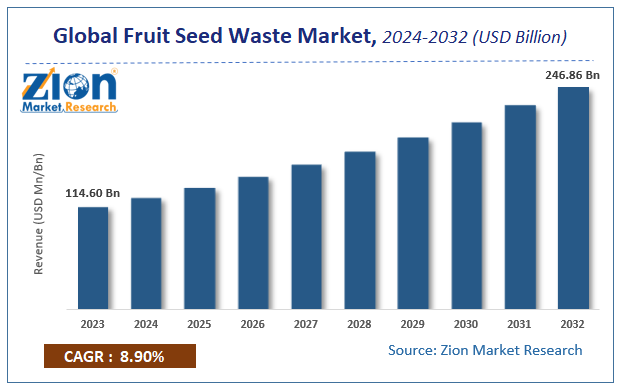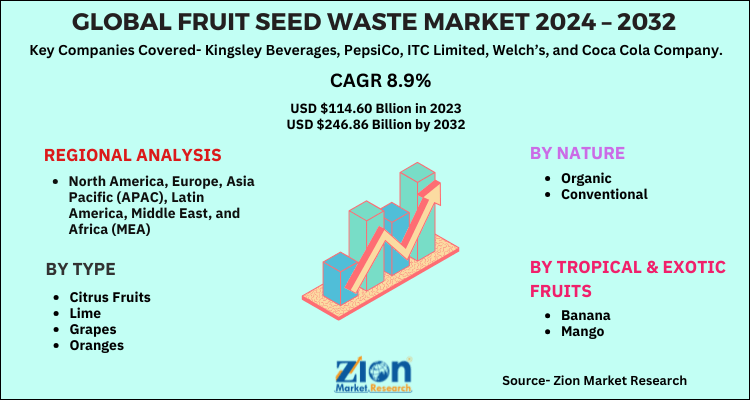Fruit Seed Waste Market is set for a Rapid Growth and is further growing at a CAGR of 8.9% by 2032
18-Sep-2024 | Zion Market Research
Zion Market Research has published a new report titled “Fruit Seed Waste Market by Nature (Organic and Conventional), by Fruit Type (Citrus Fruits, Lime, Grapes, and Oranges), by Tropical & Exotic Fruit (Banana and Mango), and by Stone Fruit (Plum, Apricots, and Peaches): Global Industry Perspective, Comprehensive Analysis, and Forecast,2024-2032. Fruit Seed Waste Market, estimating its value at USD 114.60 Billion in 2023, with projections indicating that it will reach USD 246.86 Billion by 2032. The market is expected to expand at a compound annual growth rate (CAGR) of 8.9% over the forecast period 2024-2032
Browse the full “Fruit Seed Waste Market: by Nature (Organic and Conventional), by Fruit Type (Citrus Fruits, Lime, Grapes, and Oranges), by Tropical & Exotic Fruit (Banana and Mango), and by Stone Fruit (Plum, Apricots, and Peaches): Global Industry Perspective, Comprehensive Analysis, and Forecast, 2024-2032” Report at https://www.zionmarketresearch.com/report/fruit-seed-waste-market

With the growing population and changing diet habits, the production and processing of horticultural crops, especially fruits and vegetables, have increased very significantly to fulfill the increasing demands. Significant losses and waste in the fresh and processing industries are becoming a serious nutritional, economical, and environmental problem. For example, the United Nations Food and Agriculture Organization (FAO) has estimated that losses and waste in fruits and vegetables are the highest among all types of foods, and may reach up to 60%. The processing operations of fruits and vegetables produce significant wastes of by-products, which constitute about 25% to 30% of a whole commodity group. The waste is composed mainly of seed, skin, rind, and pomace, containing good sources of potentially valuable bioactive compounds, such as carotenoids, polyphenols, dietary fibers, vitamins, enzymes, and oils, among others.
Higher production and growth, and the lack of proper handling methods and infrastructure, have led to huge losses and waste of these important food commodities, as well as their components and by-products and residues. For example, the United Nations Food and Agriculture Organization (FAO) has estimated that at least one-third of the food produced in the world (estimated as 1.3 billion metric tons) is lost and wasted every year (FAO 2014), and losses and waste of horticultural commodities are the highest among all types of foods, reaching up to 60%. Losses and waste occur during all phases of the supply and handling chain, including during harvesting, transport to packinghouses or markets, classification and grading, storage, marketing, processing, and at home before or after preparation. Losses occur throughout the supply chain from production throughout all postharvest stages before consumption.
Based on the fruit type, the fruit seed waste market has been segmented into citrus fruits, lime, grapes, and oranges. The citrus fruit segmented is anticipated to gain substantial market share over the forecast timeline. Citrus waste is a rich source of phenolic compounds because the citrus peel contains a higher quantity of polyphenols in comparison with the edible part of the fruit. Apart from citrus, the peels of other fruits have also been found to contain higher concentrations of phenolics compared with the edible portions. It has been found that double amounts of total phenolics in the peels of apples, peaches, and pears compared to peeled fruits. Pomegranate peels contain 249.4 mg/g phenolic compounds, while the pulp contains 24.4 mg/g. Apple peels were reported to have up to 3300 mg/100 g DM of phenolic content. Grape skins and seeds, by-products of the juice and wine industries, are also rich sources of mono-, oligo-, and polymeric proanthocyanidins (phenolics).

In terms of tropical & exotic fruits, the fruit seed waste market has been classified into banana and mango. It was reported that banana pulp contains 232 mg/100 g DM of phenolic compounds, which is only about 25% of that found in the peel. Along with phenolic compounds, higher amounts of catecholamines, dopamine, and l-dopa were also found in banana peels.. 80 to 90 percent of citrus wastes are converted into usable products, such as dried pulp, molasses, pectin, essential oils, brined peel, citric acid, limonene, feed yeast, and biologically active materials. Citrus seeds are a source of food oils. Some seed oil was produced in Florida in the late 1930s, but operations were suspended until 1946. During the 1948-49 season the estimated oil recovery was between 300 and 400 tons in Florida. The potential supply from wastes from Florida citrus canneries is estimated at more than 5,000 tons. Some varieties of citrus fruit, such as the navel orange and the Marsh seedless grapefruit, have few seeds, but others, the Seedling orange and Duncan grapefruit, for example, contain many.
Some key players in operating in the fruit seed waste market are Kingsley Beverages, PepsiCo, ITC Limited, Welch’s, and Coca Cola Company.
This report segments the global fruit seed waste market as follows:
Global Fruit Seed Waste Market: Nature Segment Analysis
- Organic
- Conventional
Global Fruit Seed Waste Market: Fruit Type Segment Analysis
- Citrus Fruits
- Lime
- Grapes
- Oranges
Global Fruit Seed Waste Market: Tropical & Exotic Fruits Segment Analysis
- Banana
- Mango
Global Fruit Seed Waste Market: Regional Segment Analysis
- North America
- U.S.
- Europe
- UK
- France
- Germany
- Asia Pacific
- China
- Japan
- India
- Latin America
- Brazil
- Middle East and Africa
About Us:
Zion Market Research is an obligated company. We create futuristic, cutting-edge, informative reports ranging from industry reports, the company reports to country reports. We provide our clients not only with market statistics unveiled by avowed private publishers and public organizations but also with vogue and newest industry reports along with pre-eminent and niche company profiles. Our database of market research reports comprises a wide variety of reports from cardinal industries. Our database is been updated constantly in order to fulfill our clients with prompt and direct online access to our database. Keeping in mind the client’s needs, we have included expert insights on global industries, products, and market trends in this database. Last but not the least, we make it our duty to ensure the success of clients connected to us—after all—if you do well, a little of the light shines on us.
Contact Us:
Zion Market Research
244 Fifth Avenue, Suite N202
New York, 10001, United States
Tel: +49-322 210 92714
USA/Canada Toll-Free No.1-855-465-4651
Email: sales@zionmarketresearch.com
Website: https://www.zionmarketresearch.com
Zion Market Research
Tel: +1 (302) 444-0166
USA/Canada Toll Free No.+1 (855) 465-4651
3rd Floor,
Mrunal Paradise, Opp Maharaja Hotel,
Pimple Gurav, Pune 411061,
Maharashtra, India
Phone No +91 7768 006 007, +91 7768 006 008
US OFFICE NO +1 (302) 444-0166
US/CAN TOLL FREE +1 (855) 465-4651
Email: sales@zionmarketresearch.com
We have secured system to process your transaction.
Our support available to help you 24 hours a day, five days a week.
Monday - Friday: 9AM - 6PM
Saturday - Sunday: Closed


